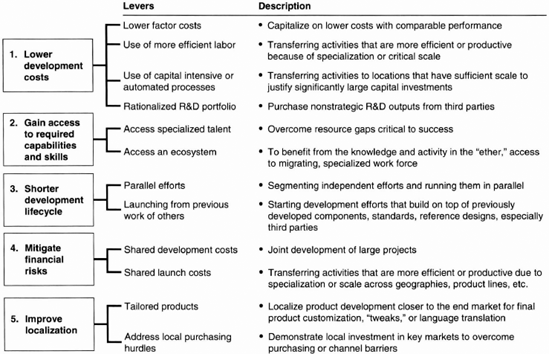11.3. The Benefits of DNPD
Based on our analysis and discussions with practitioners using distributed processes, DNPD can offer up to five distinct benefits to a company: lower development costs, access to greater capabilities and specialized skills, shorter development times, better risk management, and improved product targeting (see Figure 11.1). Obviously, the nature and magnitude of each benefit will vary according to your company and industry situation (more on that in Section 11.4). As you try to determine the applicability of DNPD for your projects, it is important to review the types of benefits you might achieve.
11.3.1. Lower Development Costs
There are three levers for lower development costs: labor costs, productivity gains, and focused R&D investments leveraging existing products/services:
Figure 11-1. DNPD LEVERS.

Labor factor costs, taking advantage of lower paid, often equally skilled individuals is a common occurrence and a very attractive option in labor-intensive industries. For example, in software development, coding developer resources can be ⅓ to ¼ the expense per FTE in India or Eastern Europe when compared to North America.
Improved productivity through the use of focused design or development centers that specialize in a specific capability or development step. Note that the capability may not be particularly sophisticated (e.g., plastic mold making) ...
Get The PDMA Handbook of New Product Development now with the O’Reilly learning platform.
O’Reilly members experience books, live events, courses curated by job role, and more from O’Reilly and nearly 200 top publishers.

